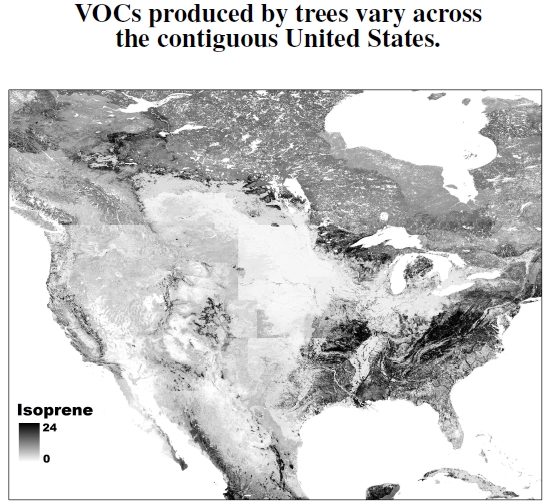4. 4 Tree VOC Map
Figure 4.4: Combining trees, vegetation, and soils, this map shows the resulting isoprene emissions (μg/m2/hr) across North America. Not surprisingly, biogenic emissions differ quite significantly from the human emissions maps of Figure 4.1, but their comparison indicates the differing importance of anthropogenic and biogenic sources of VOCs dependent on geography. Note that emissions of 1 ton per square mile per year (the unit used in Figure 4.1) equals, on average, 40 μg/m2/hr. (Image courtesy of Alex Guenther; after Guenther et al. 2006.)
The images in Figure 4.4 map biogenic VOC production across the contiguous United States, as well as much of Canada and Mexico, made by folding together species emission data with landscape-level information about local forest composition.[22] Emission rates ranged up to 24 μg/m2/hr[23] at standard conditions for air temperature on a clear day.[24]
Let’s try keeping natural emissions in perspective: Human emissions in Figure 4.1 ranged up to 20 tons per square mile, or 800 μg/m2/hr. Although biogenic concentrations are relatively low, I’ll show in Figure 4.6 that their contribution to chemical reactions can be relatively high in some places. Overall, the U.S. Environmental Protection Agency estimates natural emissions are about double that of human sources.[25]
Vegetation can also help reduce pollution. At first glance, it seems counterintuitive that cities could use trees to reduce air pollution when forests are a part of the problem; for example, some major biogenic emissions from beautiful southeastern forests sit just upwind of Durham. But, simply put, trees don’t release much reactive nitrogen, NOx (it was hard enough for them to get the nitrogen in the first place), and NOx plays a crucial role in the formation of hazardous urban air toxics (see Figure 4.7).[26] Pollution from burning fossil fuels and tree pollution aren’t the same thing.
Vegetation in urban forests can reduce airborne pollution in two ways: by physiologically fixing pollutants into plant matter and by slowing down air within, say, a tree and letting pollutants settle out onto the ground, leaves, and branches. Imagine putting a plastic, artificial Christmas tree on New Year’s Day in your backyard, under an umbrella to keep the rain and sun off but not blocking air circulation.[27] When you bring it back inside the following December, would it be clean? No, because the tree acts much like a stack of filter paper. Of course, given a choice for cleaning urban air, I would prefer a city full of evergreen trees to one full of plastic Christmas trees.[28]
Big particles like SO4, NO3 NH4, and H ions, deposit on surfaces, making the discarded plastic Christmas tree yucky, whereas SO2, HNO3, NO2, O3, NH3, can end up inside leaves.[29] In particular, ozone (O3) harms trees, leaves, and seedlings through myriad ways once the ozone enters through the stoma, the little openings that let CO2 and transpired water pass. It also causes visible damage to commercial fruits and vegetables that depend on their attractiveness for high value. One demonstration in Lahore, Pakistan, showed that the filtration of urban air having high-ozone levels increased wheat and rice yields 40% (see Figure 4.13).[30]
——————————–
[22]Guenther et al. (1994) and (2006) estimated isoprene emissions across North America.
[23]For comparison with human emissions, we need to convert the EPA units of tons per square mile per year: (2000 lbs)/(mi2)/(1 year) =(907,000 g)/(2,600,000m2)/(8760 hr) = 4.0 × 10−5 g/m2/hr = 40 μg/m2/hr.
[24]Standard conditions are a temperature of 30C and light intensity of 1,000 W/m2, roughly air temperature and the light energy reaching the ground at the equator on a clear day.
[25]A short note on the EPA website, www.epa.gov/appcdwww/apb/biogenic.htm, written some years ago by Chris Geron, states that anthropogenic VOC emissions are roughly half those of biogenic sources.
[26]Though vegetation might not release much reactive nitrogen, soil-inhabiting organisms and lightning release reactive nitrogen in natural areas (Galloway and Cowling 2002).
[27]Schlesinger and Reiners (1974) showed that a small branch of an artificial tree captured about five times more water and pollutants than an open bucket. More recent approaches place trees in wind tunnels, subject them to salt sprays, and then measure how much salt they capture (Freersmith et al. 2004).
[28]Bolund and Hunhammar (1999) summarize the literature on the physical nature of vegetation filtering out air pollutants. Smith and Jones (2000) provide a current, mechanistic overview of these processes and describe current measurement techniques.
[29]Lovett (1994) studied pollution uptake in tree leaves and also describes a number of artificial surface deposition studies.
[30]Ashmore (2005) provides an excellent discussion of ozone damage to plants, and Karnofsky et al. (2007) give a full review on the consequences for U.S. forests.

Last line on the page should read, “One demonstration in Lahore, Pakistan, showed that the filtration of urban air having high-ozone levels DEcreased wheat and rice yields 40%”